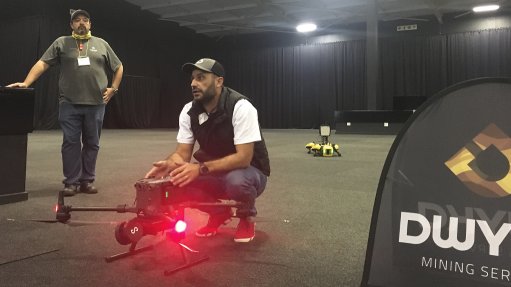
Dwyka Mining Services MD Jamie van Schoor with a DJI Matrice drone and Hovermap payload at Dwyka's Midrand offices
In its endeavours to “make tech tangible”, mining technology company Dwyka Mining Services hosted a mining technology showcase on May 18 to get clients and potential future clients physical hands-on technology to help them understand its capability and potential.
Dwyka MD Jamie van Schoor says miners and technology integration partners need to work together to drive technology on an operations level to ensure it is deployed appropriately and works to its full potential, producing the desired results.
As such, Dwyka showcased five different technologies that can improve mining efficiency; obtain better data, faster; increase capacity; and keep workers safe.
The five technologies are laser scanning volumetric measuring devices by Lase; ruggedised tablets and laptops from Getac; underground ventilation systems by Clemcorp; light detection and ranging (lidar), and simultaneous localisation and mapping (slam) technology by Emesent; drill hole- and bore-hole surveying devices by Inertial Sensing; and in-the-field data collecting and analysing devices by Skycatch.
Because “technology is moving a million miles an hour”, he says it is important to understand what is possible using technology and to also test new technology applications and concepts.
In this regard, Van Schoor says it has become evident at Dwyka that conversations about technology with miners needs to happen early in their journeys towards digitalisation and connected mines so that the appropriate technology can be implemented from the outset.
As a result, Dwyka is focusing on three key verticals in its business – real-time data, making use of digital devices and connectivity; visualisation, targeted at mission-critical assets such as people, equipment and vehicles; and intelligent automation.
However, as technology and applications evolve, Dwyka is gaining a better understanding of what miners need and, as a result, is starting to deploy its own versions of what it thinks is best suited for the African environment.
Intelligent automation is especially exciting for Dwyka, he says, as it blends real-time data with robust mine wired connectivity in an effort to access tools such as video analytics to start identifying assets like people and vehicles.
Underground connectivity is another interesting application for Dwyka, as miners endeavour to get wireless connectivity at the face as their mines progress.
This “last mile” data capability is especially critical in fully digitalising underground mines as miners can access data on mine progression to drive decision-making regarding mine development, says Van Schoor.
However, underground wireless connectivity is challenging owing to the presence of large moving machinery and otherwise adverse conditions. “No-one [else] really blows up their office every day and then moves it three metres. In the mining world, that is exactly what we do every day,” he says.
TECH ON SHOW
Clemcorp’s fans and fan technology enable miners to ventilate different areas of mines as demand is needed in certain areas, as well as to reduce ventilation to areas where less is required, thereby saving on energy costs.
Through gyro-based analysis tools by Inertial Sensing, Dwyka is assisting mining clients to drill and blast better and with more accuracy, solving problems at source instead of downstream.
In terms of drones and robotics, Dwyka is continually rolling out drone-based solutions to mining clients, with a focus on the evolving applications in which Emesent’s Hovermap scanning payload can be used.
There is also growing interest in using the dog-like robot – Spot from Boston Dynamics – to conduct field work at mines, both above-ground and underground. Van Schoor says Spot has particular applications in narrow areas where drones cannot fly and where it would be dangerous to send a human, such as in stopes and also pre- and post-blasting.
As for accessing digital information in the field or at the underground face, Dwyka says “screen sharing” is evolving very quickly, with demand for ruggedised tablets that can be used in the field to get and share data.
In this regard, Dwyka has partnered with Getac to supply ruggedised tablets and is receiving orders from batches of 30s to hundreds at a time from mining clients. “They need to be ruggedised, they cannot be [generic tablets] off the shelves . . . the processing power is [also] only getting more demanding,” he says.
In-the-field data processing and uploading of data to a cloud-based server enables access to information from anywhere in the world, as well as in real-time in the field using the Skycatch Edge 1 module. This unit is capable of downloading data, for example from a memory card of a drone camera or other payload, analyse the data and export it to handheld devices like a tablet.
To help clients measure volumes on materials handling equipment, Dwyka has partnered with Lase to deploy laser scanning volumetric measuring devices to determine output of systems like dump trucks, conveyor belts and stockpiles.
Lase’s devices can also instantly measure whether dump trucks are properly dumping all the material they are carrying, or whether they are carrying some material back into a mine – a situation that will degrade efficiency.